托福听力加试答案
【托福高分系列】托福听力加试完整答案
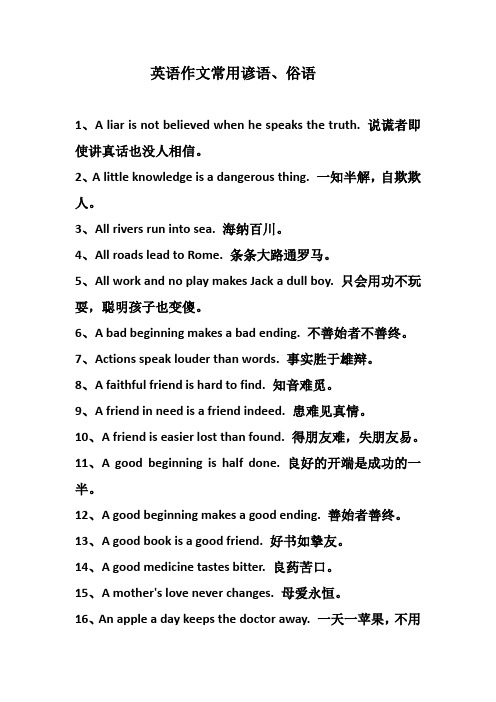
英语作文常用谚语、俗语1、A liar is not believed when he speaks the truth. 说谎者即使讲真话也没人相信。
2、A little knowledge is a dangerous thing. 一知半解,自欺欺人。
3、All rivers run into sea. 海纳百川。
4、All roads lead to Rome. 条条大路通罗马。
5、All work and no play makes Jack a dull boy. 只会用功不玩耍,聪明孩子也变傻。
6、A bad beginning makes a bad ending. 不善始者不善终。
7、Actions speak louder than words. 事实胜于雄辩。
8、A faithful friend is hard to find. 知音难觅。
9、A friend in need is a friend indeed. 患难见真情。
10、A friend is easier lost than found. 得朋友难,失朋友易。
11、A good beginning is half done. 良好的开端是成功的一半。
12、A good beginning makes a good ending. 善始者善终。
13、A good book is a good friend. 好书如挚友。
14、A good medicine tastes bitter. 良药苦口。
15、A mother's love never changes. 母爱永恒。
16、An apple a day keeps the doctor away. 一天一苹果,不用请医生。
17、A single flower does not make a spring. 一花独放不是春,百花齐放春满园。
18、A year's plan starts with spring. 一年之计在于春。
托福听力tpo40 lecture1、2、3、4 原文+题目+答案+译文
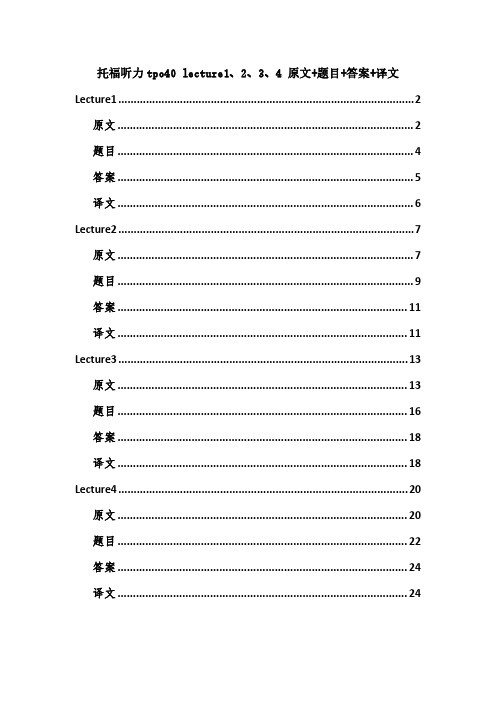
托福听力tpo40lecture1、2、3、4原文+题目+答案+译文Lecture1 (2)原文 (2)题目 (4)答案 (5)译文 (6)Lecture2 (7)原文 (7)题目 (9)答案 (11)译文 (11)Lecture3 (13)原文 (13)题目 (16)答案 (18)译文 (18)Lecture4 (20)原文 (20)题目 (22)答案 (24)译文 (24)Lecture1原文NARRATOR:Listen to part of a lecture in an art history class.MALE PROFESSOR:Last class I passed out your assignment for your first paper,and today I want to spend some time going over it.Mm…most people never take any art history until they get to college,so many of you have probably never written an art history paper before.I gave you a list of appropriate works of art for you to write about.So your next step in this process needs to be to go look at the work you've selected as your topic.And bring a pencil and a notepad with you,because I don't mean you should just drop by at the museum and glance at it so you can say you've seen it in real life.You need to go and sit in front of the work and really look at it—carefully and slowly.And keep careful notes about what you see—you’ll need them for the kind of art history paper you're going to be writing…it's what we call a formal analysis.A formal analysis of a work of art,any kind of art,is based on its formal qualities, which means qualities related to the form—things like color…texture…line…shapes…proportion…and composition.Probably the closest thing to a formal analysis you might have written is for an English class.If you've…say…written an analysis of a poem,you've used the same skills—you've given an analysis of the poem by describing and analyzing its form and meter.A formal analysis paper in art history is very similar.Now,before you begin writing your formal analysis,you'll want to start with a summary of the overall appearance of the work—a brief description of what you see. Are there figures—people?What are they doing?Or is it a landscape…or an abstract representation of something?Tell what the subject is,and what aspects are emphasized in the painting.This will give your reader an overview of what the work looks like before you analyze it.The next part of your paper—the actual formal analysis—will be the longest and most important section of your paper,where you describe and analyze individual design elements.For this portion of the paper,you're going to rely on the notes you took at the museum,because you should be able to describe in detail the design elements the artist uses,and how they are used.For example,does the artist use harsh lines or soft lines—are the colors bright or muted?Focus on the design elements that you feel are most strongly represented in that particular work of art. And if you don't know where to begin,take note of where your eye goes first.Then describe things in the order in which your eye moves around the work.This will help you understand how one part relates to another—the interaction between the different parts of the work.OK,this kind of analysis should occur throughout the main portion of the paper.In the last section of your paper—and this goes beyond formal analysis—you comment on the significance of what you have seen.What details of the work convey meaning?Some significant details will not be apparent to you right away,but if you look long enough,you realize how important they are for your interpretation of the work.Many years ago,I was writing a formal analysis of a painting of a little boy.In the painting,a little boy was standing in his nursery,and he was holding a toy bird in his hand,and there were more toys around him in the background of the painting. Because of the bird he was holding,I assumed at first that the painting was about the innocence of children.But as I looked at the painting longer,I realized that the boy's eyes looked sad even though there was no discernable expression on his face.And then it dawned on me that,even though he was surrounded by toys,he was all alone in his nursery.The boy's eyes were a significant detail in the painting,that I didn't notice at first.题目1.What point does the professor make about the writing of a formal analysis in art history?A.Its objective is to identify common features of several works of art.B.Its most important part is the explanation of an artwork's significance.C.Several styles of writing a formal analysis are used by art historians.D.A particular approach is required to present Information about an artwork.2.According to the professor,what will students need to do before writing the art history paper?A.Look at examples of formal analysis in textbooksB.Take notes on the artwork they will write aboutC.Go to different museums before selecting a topic for the paperD.Study the historical context of the artwork they will write about3.Why does the professor mention an English class?A.To explain the difference between visual language and written languageB.To explain that students need good writing skills for their assignmentC.To point out similarities between a poetry paper and the students'assignmentD.To point out that many art historians become writers4.What does the professor recommend as a way to understand the relationship between different parts of an artwork?A.Looking for lines that connect different parts of the workB.Examining the artwork from several different anglesC.Looking for similar colors the artist used throughout the workD.Determining how the viewer's eyes move around the work5.Why does the professor talk about his own experience analyzing the painting of a little boy?A.To point out a common misconception about formal analysisB.To stress the importance of looking at an artwork thoroughlyC.To show why a formal analysis should not emphasize small detailsD.To provide an example of an artwork that is easy to analyze6.The professor describes three sections the art history paper should contain.Place them in the order in which they should appear in the paper.Click on a phrase.Then drag it to the space where it belongs.A.Analysis of the design elements the artist usesB.Discussion of the meaning of the artworkC.Summary of the appearance of the artwork答案D B C D B CAB译文旁白:下面听一段艺术史课程的片段。
toefl听力加试全答案
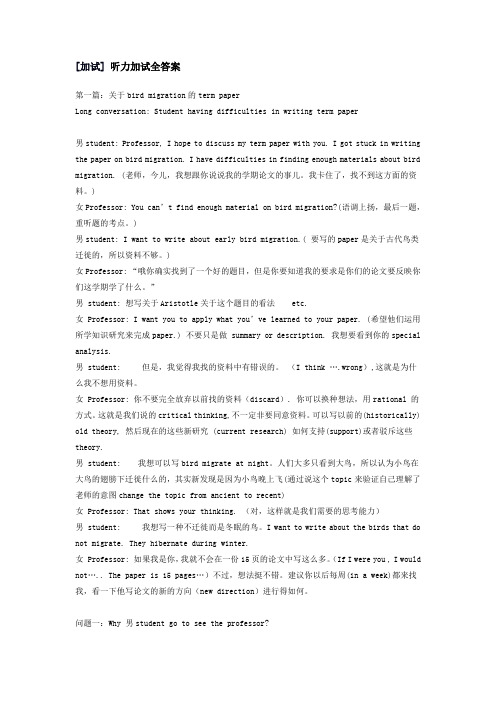
[加试]听力加试全答案第一篇:关于bird migration的term paperLong conversation: Student having difficulties in writing term paper男student: Professor, I hope to discuss my term paper with you. I got stuck in writing the paper on bird migration. I have difficulties in finding enough materials about bird migration. (老师,今儿,我想跟你说说我的学期论文的事儿。
我卡住了,找不到这方面的资料。
)女Professor: You can’t find enough material on bird migration?(语调上扬,最后一题,重听题的考点。
)男student: I want to write about early bird migration.( 要写的paper是关于古代鸟类迁徙的,所以资料不够。
)女Professor: “哦你确实找到了一个好的题目,但是你要知道我的要求是你们的论文要反映你们这学期学了什么。
”男 student: 想写关于Aristotle关于这个题目的看法 etc.女 Pro fessor: I want you to apply what you’ve learned to your paper. (希望他们运用所学知识研究来完成paper.) 不要只是做 summary or description. 我想要看到你的special analysis.男 student: 但是,我觉得我找的资料中有错误的。
(I think ….wrong),这就是为什么我不想用资料。
女 Professor: 你不要完全放弃以前找的资料(discard). 你可以换种想法,用rational 的方式。
神一样的背托福加试答案!!!后辈们好好收藏!!!

神一样的背托福加试答案!!!后辈们好好收藏!!!听力加试:(因为现在的听力加试出现了几个版本,所以最好在考试的时候确定一下)如何使用:一声A二声B三声C四声D....关于鸟的迁徙的论文:答案:C A BD A B转化后:小子,不要飞离大王花:答案:C D A B B C转化后:我要吃红苹果拉格泰姆音乐:答案:C C CD B A A转化后:我只想要重新听女生丢ID卡:答案:D A C D D转化后:就光喊救命至于神经元细胞和浪漫主义诗人的话可能就应该去看具体的机经了暂时还没有确定答案。
阅读加试:(阅读加试的顺序一般没有改过所以大家可以放心用)电报:ABADC BBDBC BDC ACD转化后:今年他不想盘盘被群秒还要我A角兽(玩魔兽的同学,应该不会陌生)鸟唱:DCBAB BDACA DC BECFD转化后:要我陪他明年这天找些乐子25364(这个因为超出了ABCD,所以旧把它当成工号记下吧)达尔文进化论:AADAC BCAAB ABB ACD转化后:今天舅逼我没有穿衣还吃毛虫真有病巴比伦文明:CCAAA DBCDA DD 16/347转化后:小宝他应该要连着背七句话16/347 (最后是分类题,没有办法)三声:我,有,想,秒,找,Muban-integratedIn the lecture, the speaker states that (the general point of the lecture),casting doubt on/bolstering the main idea of the reading passage that (the general point of the article).First of all, c ontrary tothe belief in the passage that …, the speaker says that…In addition, the speaker refutes the viewpoint showed in the passage that…. In fact,Finally, opposing tothe standpoint in the reading passage that…, the speaker claims thatTo sum up, the speaker illustrates his/her disagreement with the idea ofthe passageby elaborating three evidences mentioned above.一边倒First of all,furthermore, in additionversion 9-23:1.interrogative sentence?On the basis of different personal experiences and philosophies, people hold various opinions.2.On the basis of personal experiences and philosophies, some people hold the view that____.Others, however, have an opposite attitude that____Frankly speaking, there are both advantages and disadvantages….As far as I am concerned, Iprefer the idea that ____even though there are some drawbacks of students’ taking classes in many subjects.Among numerous factors sustaining my viewpoint, prominent aspects are listed as follows.In the first place, the most important reason is原因1In the second place, another equally significant reason of choosing AAA lies in the development of ---.This significant point, however, is often unconsciously overlooked by most people.Of course, I have to admit that in the meantime AAA also (brings out a lot of problems/has some drawbacks) such as…However, considering all the factors above, it is revealed that the advantages of AAA outstrip those of BBB.To sum up, from what has been discussed, we may safely draw the conclusion that AAA can benefit not only because 原因1 but also原因2. Therefore, I prefer to AAA. 统一口语模板museum1、Chengdu Municipal Museum has a complete collection of both ancient and modern Chinese artworks, including calligraphy,paintings, etc.And just looking at the display is a feastfor the eyes because these artifacts are so elaborate that I could hardly believe that they were made hundreds and even thousandsof years ago. Besides, their creative design reminds of me the long and splendid civilizationin our country. Appreciating these items and discussing their influenceson art with my friends and family is really an enjoyment which keep me away from thenoisy metropolis, enjoying our ancestors’ creation.1)最重要的一个决定(chose to be a doctor, last time His face was like yellow wax, his eyes darkened, as they were sightless, cure cancer)2)空闲时做的事(喜欢逛博物馆, steven and I often go to museum, last time he ask me to go to museum when he recovered )3)所居住的城市中你最喜欢的地方(博物馆)4)你和朋友在一起的时候喜欢去哪个地方(博物馆)5)你通常喜欢去什么park或者public area (博物馆)9)描述一个你没去但是很想去的地方(北京的首都博物馆)10)Describe an interesting book/最有用的一本书(讲述博物馆的故事, steven give it to me as a birthday gift)11)描述一次challenging experience, 以及如何解决这个challenge (一次博物馆调查)12)Describe a special opportunity given to you (for free免费参观博物馆的机会)13) Some good news and why(steven recovered, time listened about the news, I can’t stop my tears of joy.)14)what do u miss most when away from home?(家附近的博物馆)15)what do u do to relax yourself?(去博物馆放松身心,以前就跟steven relax)16)政府是否应该资助建博物馆和剧院。
托福听力测试题及答案
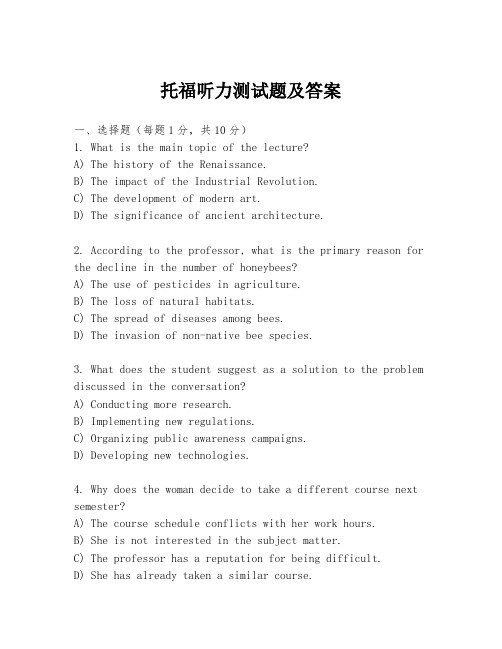
托福听力测试题及答案一、选择题(每题1分,共10分)1. What is the main topic of the lecture?A) The history of the Renaissance.B) The impact of the Industrial Revolution.C) The development of modern art.D) The significance of ancient architecture.2. According to the professor, what is the primary reason for the decline in the number of honeybees?A) The use of pesticides in agriculture.B) The loss of natural habitats.C) The spread of diseases among bees.D) The invasion of non-native bee species.3. What does the student suggest as a solution to the problem discussed in the conversation?A) Conducting more research.B) Implementing new regulations.C) Organizing public awareness campaigns.D) Developing new technologies.4. Why does the woman decide to take a different course next semester?A) The course schedule conflicts with her work hours.B) She is not interested in the subject matter.C) The professor has a reputation for being difficult.D) She has already taken a similar course.5. What is the main purpose of the campus tour mentioned in the lecture?A) To introduce new students to the campus facilities.B) To highlight the university's academic achievements.C) To promote the university to potential students.D) To raise funds for campus improvements.二、填空题(每题1分,共5分)6. The speaker mentions that the _______ is a key factor in determining the success of a business.7. In the dialogue, the man suggests that they should _______ before making a decision.8. The professor explains that the _______ theory has been widely accepted in the field of psychology.9. The woman is concerned about the _______ of the new policy on the local community.10. The student is looking for a part-time job that offers_______ and flexible hours.三、简答题(每题2分,共4分)11. Summarize the main points of the lecture on environmental conservation.12. What are the potential benefits of the proposed research project discussed in the conversation?四、论述题(每题3分,共3分)13. Discuss the role of technology in modern education andits implications for the future of learning.答案:1-5: D A C A C6. innovation7. consult with an expert8. cognitive dissonance9. impact10. health insurance11. The lecture covered the importance of biodiversity, the threats to natural habitats, and the need for sustainable practices.12. The research could lead to new treatments for diseases, improve public health, and contribute to scientific knowledge.13. Technology has revolutionized education by providing access to a wealth of information and interactive learning tools. However, it also raises concerns about the potential loss of human interaction and the digital divide.。
【必备资料】托福听力经典加试题真题及解析汇总

【必备资料】托福听力经典加试题真题及解析汇总
对于正在备考托福听力的学生来说,托福听力的加试题,并不是一件非常奇怪的事情,也可以这样说,他也是我们备考过程中一项必备的项目内容。
因为,在托福听力的考试中,遇到听力加试的可能性还是很大的。
下面就为大家介绍一下托福听力加试题。
据托福官方解释,考试中出现加试题是非常正常的,可以说几乎每一种考试,特别是比较科学性的考试,都会有加试题的存在,只不过ETS在这一方面做得比较透明化,告诉大家我们这些题中有加试题,而加试题的目的是在于试题的研发以及测试,并不会影响考生的实际成绩,当然为了确保考试的公正性,ETS 在设置加试题的量上以及时间上都是有严格的控制的,会保证量的公正性。
考生在考试过程中,并不会感受到觉察出哪些是加试题,并不影响你的考试,你对加试题回答的正确与否,也不会影响你的考试成绩,加试题是不算成绩的。
因此大家只需要如常的进行考试即可。
以下点课台教育就为大家详细列出了托福听力经典加试题真题及解析汇总,希望能为大家的考试带来帮助。
托福听力经典加试:神经元细胞(试题及答案)
托福听力加试:英国浪漫主义诗歌(试题及答案)
新托福听力经典加试:拉格泰姆音乐(试题及答案)
新托福听力经典加试:大王花(题目及答案)
新托福听力经典加试:鸟类迁徙(题目及答案)。
托福听力测试题及答案

托福听力测试题及答案
1. 听下面对话,回答以下问题:
对话中提到的会议是在什么时候举行的?
A. 上午9点
B. 下午3点
C. 晚上7点
D. 没有提及具体时间
答案:B
2. 听下面讲座,回答以下问题:
教授在讲座中提到了哪种动物的迁徙行为?
A. 蝴蝶
B. 鲸鱼
C. 企鹅
D. 鸟类
答案:A
3. 听下面对话,回答以下问题:
学生为什么去找教授?
A. 询问作业
B. 寻求建议
C. 讨论成绩
D. 报告问题
答案:B
4. 听下面讲座,回答以下问题:
讲座中提到的艺术家是哪个国家的?
A. 法国
B. 意大利
C. 西班牙
D. 荷兰
答案:D
5. 听下面对话,回答以下问题:
对话中提到的图书馆在哪里?
A. 校园中心
B. 校园东边
C. 校园西边
D. 校园北边
答案:C
6. 听下面讲座,回答以下问题:
讲座中提到的实验结果是什么?
A. 成功
B. 失败
C. 需要进一步研究
D. 无法确定
答案:C
7. 听下面对话,回答以下问题:
对话中提到的天气如何?
A. 晴朗
B. 多云
C. 下雨
D. 雪
答案:C
8. 听下面讲座,回答以下问题:
讲座中提到的新技术对环境有何影响?
A. 正面影响
B. 负面影响
C. 没有影响
D. 影响未知
答案:A
结束语:以上是本次托福听力测试题及答案,希望能够帮助考生更好地准备考试。
托福听力经典加试题汇总
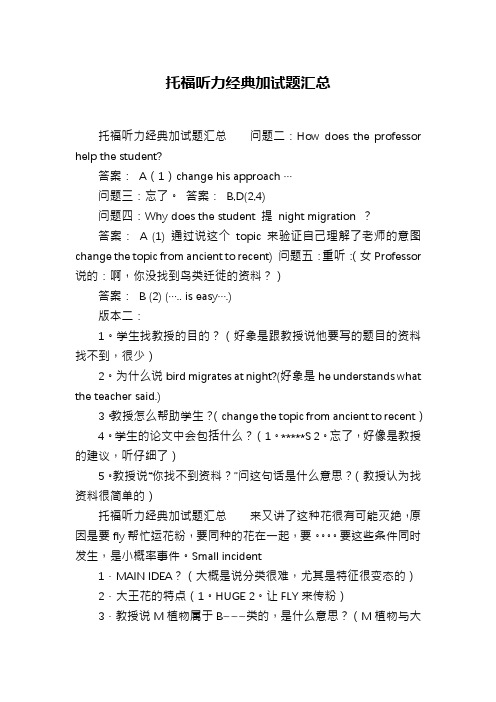
托福听力经典加试题汇总托福听力经典加试题汇总问题二:How does the professor help the student?答案:A(1)change his approach …问题三:忘了。
答案:B,D(2,4)问题四:Why does the student 提night migration ?答案: A (1) 通过说这个topic来验证自己理解了老师的意图change the topic from ancient to recent) 问题五:重听:(女Professor 说的:啊,你没找到鸟类迁徙的资料?)答案:B (2) (….. is easy….)版本二:1。
学生找教授的目的?(好象是跟教授说他要写的题目的资料找不到,很少)2。
为什么说bird migrates at night?(好象是he understands what the teacher said.)3。
教授怎么帮助学生?(change the topic from ancient to recent)4。
学生的论文中会包括什么?(1。
*****S 2。
忘了,好像是教授的建议,听仔细了)5。
教授说“你找不到资料?”问这句话是什么意思?(教授认为找资料很简单的)托福听力经典加试题汇总来又讲了这种花很有可能灭绝,原因是要fly帮忙运花粉,要同种的花在一起,要。
要这些条件同时发生,是小概率事件。
Small incident1.MAIN IDEA?(大概是说分类很难,尤其是特征很变态的)2.大王花的特点(1。
HUGE 2。
让FLY来传粉)3.教授说M植物属于B~~~类的,是什么意思?(M植物与大王花不是同一类的)4.为什么不能用DNA?(不进行光合作用)2.大王花的特点(1。
HUGE 2。
让FLY来传粉)3.教授说M植物属于B~~~类的,是什么意思?(M植物与大王花不是同一类的)4.为什么不能用DNA?(不进行光合作用)问题1. Why does the student go to see the office worker in the university service office?正确答案为:D,…new ID card.问题2. Why 女生不能出示diver license?正确答案:her wallet was stolen.问题3. Why she need to be escorted?A,……. .B,To see passport… .C,To verify… D,…….正确答案:C问题4. 根据对话所述,why 提到mealpass?正确答案:D,能和ID卡一起重新办。
托福听力tpo67 lecture1、2、3 原文+题目+答案+译文
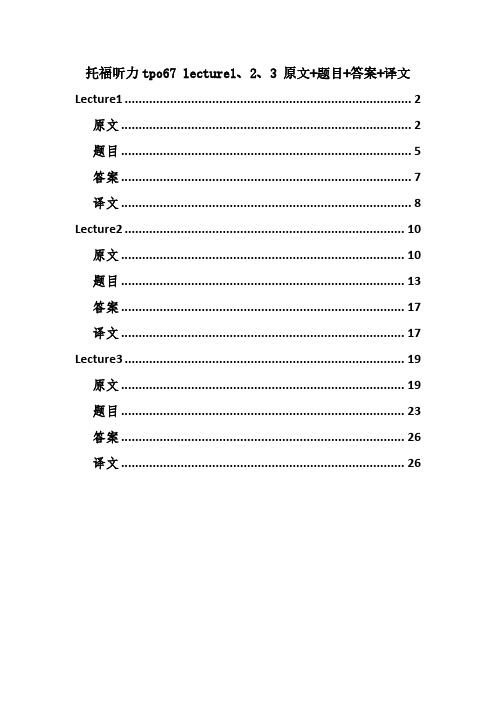
托福听力tpo67lecture1、2、3原文+题目+答案+译文Lecture1 (2)原文 (2)题目 (5)答案 (7)译文 (8)Lecture2 (10)原文 (10)题目 (13)答案 (17)译文 (17)Lecture3 (19)原文 (19)题目 (23)答案 (26)译文 (26)Lecture1原文Professor:Now we've said that animal behavior patterns involve an interplay between an animal and its environment.In particular,behavior patterns can change as an animal becomes adapted to its environment. We can see the results of this in the way that animals have developed different types of feeding behavior.Animals are generally classified as a generalist feeders and specialist feeders.Now,um,these terms are used in a variety of ways.At times,they're used to refer to an animal's range of habitats.I've also seen them used to describe the number of foraging techniques that are used by an individual or species.Um,but for our purposes,we're going to use them to refer to the range of food items that are eaten by a species.So a generalist feeder is a species that eats a wide variety of foods during its lifetime.And a specialist is a species that feeds on a highly restricted number of foods.A good example of a generalist would be a rat.Rats are notorious for eating just about anything that's available,whether it's a plant or an animal.At the other end of the spectrum,we have the koala which eats only the leaves of eucalyptus trees.Okay,now there are advantages to each.For a generalist,If1type of food isn't around,it can feed on another that's more abundant.On theother hand,the advantage of being a specialist is that the animal is well adapted to its food.You could say that specialists are feeding masters, their consumption,even their digestive system is just so finely tuned.For instance,take the koala.The eucalyptus leaves that it feeds on,don't contain much protein.What's more,the leaves contain compounds that are poisonous to most species?But the koalas digestive system has adapted to handle this.It's liver deactivates,the poisonous compounds, and its digestive system is designed to extract the maximum amount of nutrients from the leaves.So it's not a question of which strategy is better.The real question is, what determines how selective animal species are in what they eat?Well, the answer may lie in a concept called optimal foraging.The idea is that natural selection favors animals whose feeding behavior has the lowest cost to benefit ratio.That is you want to get the best healthiest food you can.And you want to do it as quickly as possible.And as easily as possible.Now,in a natural environment,no animal forage in an absolutely optimal manner.But,well,I read some research on a little rat called the kangaroo rat,which lives in deserts in North America.The kangaroo rat is a generalist which eats plant matter like seeds and fruit.It lives in deep burrows which provide protection from the desert heat and from predators like hawks or snakes.And it goes foraging at night for food.For plant matter,under the protection of darkness,even though it's a generalist.If the only thing available is seed,if a choice of seeds is available to it,it picks up seeds that provide more energy than those it leaves behind.And it carries them back to its burrow.Once it's there,it might eat only the richest seeds from the ones that brought back.So it selects seeds outside in a way that lets it spend as little time as possible foraging in that risky environment,and then sorts out its food later when it's safely in its burrow.Oh,yes,Kenneth.You have a question?Male student:But what about the koala?It gets by uh,by being even more selective,you'd think you would be really risky to rely completely on eucalyptus leaves.Wouldn't it be better to diversify like the kangaroo rat,and eat,at least one or two other things?Professor:Well,what do you think the koala would say?What do I gain by being so selective?In terms of optimal foraging,it's clear that eucalyptus trees provide an abundant source of food.Other animals can't eat the leaves and think of how little energy the koala uses.It spends only about3hours each day eating to get the energy it needs.So being a specialist allows it to get the nutrients it needs with minimal expenditure of energy.题目1.What is the lecture mainly about?A.The reasons why some animals eat only plantsB.The advantages of two different feeding adaptationsC.The variety of foods that certain animals can eatD.The relationship between two animals that share a habitat2.What definition of the term“generalist”does the professor use in the lecture?A.An animal species that eats a wide variety of foodsB.An animal species that lives in a range of different habitatsC.An animal species that uses several techniques to forage for foodD.An animal species that forages at several different times of the day3.What points does the professor make about the koala’s specialist feeding habits?[Click on2answers.]A.It obtains all the food it needs in relatively little time.B.It requires large amounts of protein in its diet.C.It can eat leaves that are poisonous to other animals.D.It spends most of its time eating.4.What does the professor imply about the kangaroo rat?A.It will take more risks when foraging for high-energy food.B.It is one of the most selective feeders in North America.C.Its competitors often eat its food supply.D.It is selective when choosing what food it eats.5.How does the professor organize the information in the lecture?A.By contrasting an old theory with a new theoryB.By defining important terms and then giving examples of themC.By describing the similarities between two animalsD.By describing a problem and then suggesting some solutions6.Why does the professor say this:Male student:But what about the koala?It gets by uh,by being evenmore selective,you'd think you would be really risky to rely completely on eucalyptus leaves.Wouldn't it be better to diversify like the kangaroo rat,and eat,at least one or two other things?Professor:Well,what do you think the koala would say?What do I gain by being so selective?In terms of optimal foraging,it's clear that eucalyptus trees provide an abundant source of food.Other animals can't eat the leaves and think of how little energy the koala uses.A.To express agreement that the koala should eat a greater variety of foodB.To indicate that the koala’s behavior does not illustrate optimal foragingC.To remind the man of the characteristics of selective feedersD.To encourage the man to consider the koala’s feeding behavior differently答案B A ACD B D译文我们已经说过动物的行为模式涉及到动物和它的环境之间的相互作用。
新托福听力经典加试全解析(共两套)

新托福听力经典加试全解析(共两套)新托福听力经典加试全解析Section 1一、conversation鸟类迁徙1. Why does the man go to see his professor?(A) He wants to change his paper topic.(B) He doesn`t understand how to analyze bird migration.(C) He cannot find enough information on his term paper topic.(D) He doesn`t understand the ideas that he has been reading about.【解析】对话开头部分,学生说:I`m having trouble finding enough sources;But I`ve only got a couple of books to work with right now.2. How does the professor help the man?(A) By suggesting a change in his approach to a paper(B) By explaining some theories about bird migration to him(C) By providing some additional examples he can use on the topic he chose(D) By giving him direction on where to find sources【解析】老师说:“you don`t need to discard the idea completely…but…take a really different focus.”3. What information will the man probably include in his paper?(A) Description of the migration habits of the Common Poorwill(B) His own analysis of early theories about bird migration(C) A comparison between birds that migrate and birds that do not(D) Current research on bird migration【解析】原文对应B:you could present what you think are some reasons;D:you`ll be supporting your views with current research4. Why does the man talk about birds that migrate at night?(A) To determinate that he understands the professor`s recommendation(B) To give examples of what he wants the professor to explain(C) To give an alternative explanation of the hibernation of the Common Poorwill(D) T o ask whether he should change his topic to the sleeping behavior of birds【解析】学生说:I think I see what you`re saying. So…Listen again to part of the conversation and then answer the question.You`re having trouble finding sources on bird migration5. What does the professor imply when she says this:(A) She`s not sure the man should write about bird migration.(B) She thinks finding sources on bird migration should be easy.(C) She`s not sure that she can help the man.(D) She thinks that man has already found enough sources on bird migration.【解析】老师的语气是反问的,她认为查找资料并不困难。
托福听力加试答案概述
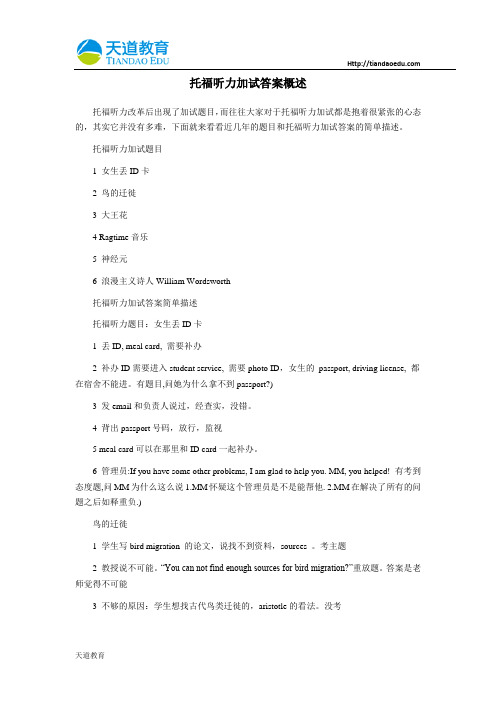
托福听力加试答案概述托福听力改革后出现了加试题目,而往往大家对于托福听力加试都是抱着很紧张的心态的,其实它并没有多难,下面就来看看近几年的题目和托福听力加试答案的简单描述。
托福听力加试题目1 女生丢ID卡2 鸟的迁徙3 大王花4 Ragtime音乐5 神经元6 浪漫主义诗人William Wordsworth托福听力加试答案简单描述托福听力题目:女生丢ID卡1 丢ID, meal card, 需要补办2 补办ID需要进入student service, 需要photo ID,女生的passport, driving license, 都在宿舍不能进。
有题目,问她为什么拿不到passport?)3 发email和负责人说过,经查实,没错。
4 背出passport号码,放行,监视5 meal card可以在那里和ID card一起补办。
6 管理员:If you have some other problems, I am glad to help you. MM, you helped! 有考到态度题,问MM为什么这么说1.MM怀疑这个管理员是不是能帮他. 2.MM在解决了所有的问题之后如释重负.)鸟的迁徙1 学生写bird migration 的论文,说找不到资料,sources 。
考主题2 教授说不可能。
“You can not find enough sources for bird migration?”重放题。
答案是老师觉得不可能3 不够的原因:学生想找古代鸟类迁徙的,aristotle的看法。
没考4 老师希望不要只是summarize, 要反映和运用这个学期的知识,可写现在新研究如何支持或者反驳过去理论,把古代鸟的迁徙改成最近鸟类迁徙。
问教授如何帮助了学生。
考老师的建议5 男生说可以写birds migrate at night。
原来以为大鸟保护小鸟,其实是小鸟晚上飞行。
考(证明自己明白老师的意图)6 男生还想写不迁徙而冬眠的鸟。
托福听力加试大王花Rafflesia原文及试题答案

托福听力加试大王花Rafflesia原文及试题答案RafflesiaListen to part of a lecture in a Botany classP: We've been talking about plant classifications and how species belong to a family and families belong to an order, but sometimes, figuring out how we assign certain plant species to a particular order is challenging, even if the plant has...unusual characteristics. You'd think that plants with similar characteristics would belong to the same order, but that's not always true. A good example of this is a flower, that is—a flowering plant—that grows only in Malaysia and Indonesia, called Rafflesia.As you can see, Rafflesia is a pretty unusual plant. For starters, it's huge. The flower can grow up to a meter in width and can weigh up to seven kilos—pretty big, huh There aren't any other specimens in the plant world that have flowers even close to this size. But that's not the only unusual characteristic of Rafflesia, in fact, that's probably one of the least strange features of the plant.The plant also emits a terrible stench, like rotting meat. But again, there are other plants with bad smelling flowers. And in the case of Rafflesia, flies are attracted to that smell, and that's how the flowers get pollinated. So...um...Rafflesia's flowers are huge and smelly. Rafflesia is also a parasite; it gets its energy from another plant instead of from the sun, which is unusual, but not unheard of in the plant kingdom. It actually grows inside its host, which is a type of grapevine. I mean... it grows inside its host until it blooms—it doesn't bloom inside the host. But that leads me to...I want to tell you really quickly about another plant, a plant that's also from the forests of Southeast Asia, called Mitrastema.Now, Mitrastema is also a parasite, which led some to believe that Rafflesia was related to Mitrastema—that they belong to the same order. Mitrastema as I said is a parasite, but its flowers are much smaller, and don't smell bad, so you can see why there was debate about whether they were related. But as it turns out, Mitrastema is actually related to blueberries. So, even plants that share an unusual characteristic with Rafflesia are not related to it. And, um...no plant shares all three of its unusual characteristics, and that made classifying Rafflesia very, very difficult.Now, you're probably thinking, why don't they just analyze the DNA of the plant Well, as I said, Rafflesia is a parasite. It lacks the leaves; the green tissue that most plants need for photosynthesis. It's unable to...um...to capture the sunlight most other plants use to make food. So, it's lacking...it...it...it doesn't have the DNA—the genes—for photosynthesis, which is what we usually use to classify plant species. But some researchers in Michigan persisted, and analyzed about 90 species of seed plants and compared them to Rafflesia, and we finally had an answer. Rafflesia was part of the Malpighiales order.Now, other species in the Malpighiales order includeviolets...um...poinsettias...uh...passion-flowers...what else Willows. So it was pretty unexpected because flowers like violets are a lot smaller than Rafflesia, right And they don't smell bad—they don't smell like rotting meat...and they're not parasitic. It took almost 200 years to classify Rafflesia, to identify its relatives, and I don't think anyone would have ever guessed that it's in the order Malpighiales. I mean...you know-it'd be nice to be able to classify species based on their obvious characteristics, but, it didn't work that way with Rafflesia. And unfortunately for Rafflesia, and for the field of botany, it seems that Rafflesia may be dying out. It's certainly endangered because of deforestation in its habitat. And to make matters worse, Rafflesia doesn't reproduce very well. First of all, only 10-20% of buds turn intofull-fledged flowers, and it can take them a year to grow. There are also male flowers and female flowers, and one of each has to be in the same area—the same vicinity—at the same time, to produce seeds, and the flies that are attracted to the flower's strong smell have to carry pollen from one flower to the other, so how often do you think these events occur all together Even people who study the plant for years may never witness it.考题:问题一:主旨题What is the lecture mainly about正确答案:(C) 植物的分类困难。
新托福听力加试题最新整理附答案
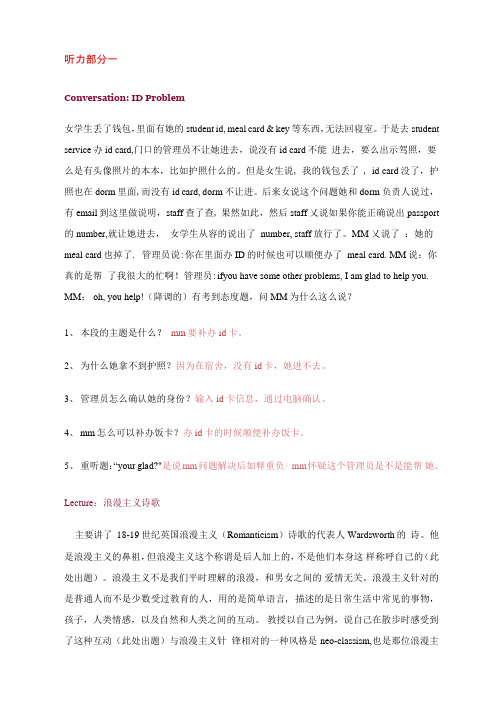
听力部分一Conversation: ID Problem女学生丢了钱包,里面有她的student id, meal card & key等东西,无法回寝室。
于是去student service办id card,门口的管理员不让她进去,说没有id card不能进去,要么出示驾照,要么是有头像照片的本本,比如护照什么的。
但是女生说, 我的钱包丢了 , id card没了,护照也在dorm里面,而没有id card, dorm不让进。
后来女说这个问题她和dorm负责人说过,有email到这里做说明,staff查了查, 果然如此,然后staff 乂说如果你能正确说出passport 的number,就让她进去,女学生从容的说出了number, staff放行了。
MM 乂说了:她的meal card也掉了. 管理员说:你在里面办ID的时候也可以顺便办了meal card. MM说:你真的是帮了我很大的忙啊!管理员:ifyou have some other problems, I am glad to help you. MM: oh, you help!(降调的)有考到态度题,问MM为什么这么说?1、本段的主题是什么?mm要补办id卡。
2、为什么她拿不到护照?因为在宿舍,没有id卡,她进不去。
3、管理员怎么确认她的身份?输入id卡信息,通过电脑确认。
4、mm怎么可以补办饭卡?办id卡的时候顺便补办饭卡。
5、重听题:“your glad?"是说mm问题解决后如释重负/ mm怀疑这个管理员是不是能帮她。
Lecture:浪漫主义诗歌主要讲了18-19世纪英国浪漫主义(Romanticism)诗歌的代表人Wardsworth的诗。
他是浪漫主义的鼻祖,但浪漫主义这个称谓是后人加上的,不是他们本身这样称呼自己的(此处出题)。
浪漫主义不是我们平时理解的浪漫,和男女之间的爱情无关。
浪漫主义针对的是普通人而不是少数受过教育的人,用的是简单语言, 描述的是日常生活中常见的事物,孩子,人类情感,以及自然和人类之间的互动。
托福听力经典加试题及答案(汇总)
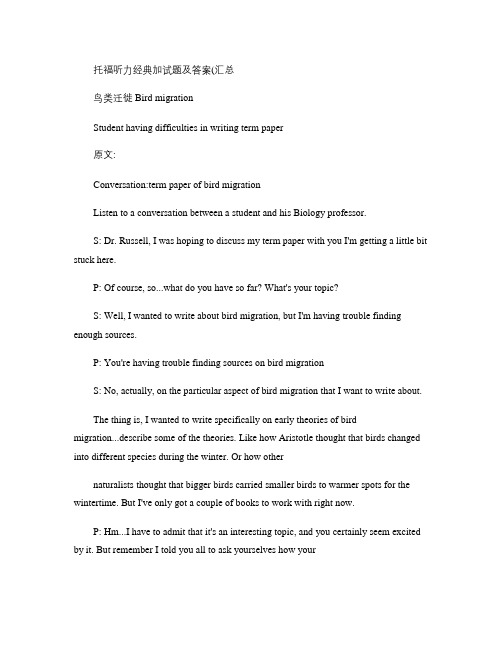
托福听力经典加试题及答案(汇总鸟类迁徙Bird migrationStudent having difficulties in writing term paper原文:Conversation:term paper of bird migrationListen to a conversation between a student and his Biology professor.S: Dr. Russell, I was hoping to discuss my term paper with you I'm getting a little bit stuck here.P: Of course, so...what do you have so far? What's your topic?S: Well, I wanted to write about bird migration, but I'm having trouble finding enough sources.P: You're having trouble finding sources on bird migrationS: No, actually, on the particular aspect of bird migration that I want to write about.The thing is, I wanted to write specifically on early theories of bird migration...describe some of the theories. Like how Aristotle thought that birds changed into different species during the winter. Or how othernaturalists thought that bigger birds carried smaller birds to warmer spots for the wintertime. But I've only got a couple of books to work with right now.P: Hm...I have to admit that it's an interesting topic, and you certainly seem excited by it. But remember I told you all to ask yourselves how yourtopic is going to help you show that you can apply what you've learned this semester.A summary or description is not really what I'm looking for as much as your analysis of a certain topic.S: I guess it's not really what we're supposed to do, huhP: Right. So, how about we think about some other ideas for your paper. I mean you don't need to discard the idea completely... but... take a really different focus. Um... for example...you could present what you think are some reasons-the rationale-behind some of the erroneous theories early naturalists had. But, you'll be supporting your views with current research; those are the sources you'll need to seek out.S: Ok, I think I see what you're saying. So, like today...today we know that lots of small birds migrate at night, but maybe `cause people didn't see them-didn't see the small birds migrating-they only saw bigger birds, like geese migrating during the day. They thought that the big birds were carrying the small ones under their wings.P: There you go! That's exactly what I mean. You're showing that you're thinking about the topic, not just telling me what you read.S: Ok, I also have a really cool example of a migratory bird that I'd like to discuss in my paper. It's the Common Poorwill—I mean it seems that some Ornithologists believe that the Common Poorwill really does hibernate instead of migrating-that it's maybe the only bird that does.P: If I were you, I would stick just with migration research. Remember, this is only a 15-page paper.S: Ok, I see your point.P: But it's great that you're finding this all so interesting. I want you to come back to see me in a week so we can take a look at the new direction in your paper and evaluate the sources you've found in the meantime.中文大意:Male Student:老师,我想跟你讨论一下我的学期论文。
- 1、下载文档前请自行甄别文档内容的完整性,平台不提供额外的编辑、内容补充、找答案等附加服务。
- 2、"仅部分预览"的文档,不可在线预览部分如存在完整性等问题,可反馈申请退款(可完整预览的文档不适用该条件!)。
- 3、如文档侵犯您的权益,请联系客服反馈,我们会尽快为您处理(人工客服工作时间:9:00-18:30)。
第一篇:关于bird migration的term paperLong conversation: Student having difficulties in writing term paper男student: Professor, I hope to discuss my term paper with you. I got stuck in writing the paper on bird migration. I have difficulties in finding enough materials about bird migration. (老师,今儿,我想跟你说说我的学期论文的事儿。
我卡住了,找不到这方面的资料。
)女Professor: You can’t find enough material on bird migration?(语调上扬,最后一题,重听题的考点。
)男student: I want to write about early bird migration.( 要写的paper是关于古代鸟类迁徙的,所以资料不够。
)女Professor: “哦你确实找到了一个好的题目,但是你要知道我的要求是你们的论文要反映你们这学期学了什么。
”男student: 想写关于Aristotle关于这个题目的看法 etc.女Professor: I want you to apply what you’ve learned to your paper. (希望他们运用所学知识研究来完成paper.) 不要只是做summary or description. 我想要看到你的special analysis.男student: 但是,我觉得我找的资料中有错误的。
(I think ….wrong),这就是为什么我不想用资料。
女Professor: 你不要完全放弃以前找的资料(discard). 你可以换种想法,用rational 的方式。
这就是我们说的critical thinking,不一定非要同意资料。
可以写以前的(historically) old theory, 然后现在的这些新研究(current research) 如何支持(support)或者驳斥这些theory. 男student: 我想可以写bird migrate at night。
人们大多只看到大鸟,所以认为小鸟在大鸟的翅膀下迁徙什么的,其实新发现是因为小鸟晚上飞(通过说这个topic来验证自己理解了老师的意图change the topic from ancient to recent)女Professor: That shows your thinking. (对,这样就是我们需要的思考能力)男student: 我想写一种不迁徙而是冬眠的鸟。
I want to write about the birds that do not migrate. They hibernate during winter.女Professor: 如果我是你,我就不会在一份15页的论文中写这么多。
(If I were you , I would not….. The paper is 15 pages…)不过,想法挺不错。
建议你以后每周(in a week)都来找我,看一下他写论文的新的方向(new direction)进行得如何。
问题一:Why 男student go to see the professor?答案: C(3)he cannot find enough material in writing his paper.问题二:How does the professor help the student?答案: A(1)change his approach …问题三:忘了。
答案: B,D(2,4)问题四:Why does the student 提night migration ?答案: A (1) 通过说这个topic来验证自己理解了老师的意图change the topic from ancient to recent)问题五:重听:(女Professor说的:啊,你没找到鸟类迁徙的资料?)答案:B (2) (….. is easy….)第二篇:大王花大王花Rafflesia教授一开始就介绍植物分类,提到分类中的species种,genus属,order目。
说植物的classification 很难,一些特性比较特殊的植物特别是这个样子。
提出植物的分类不能完全依靠它flower的形态和特性。
提到Rafflesia(大王花),开花石会散发腐臭的味道,以吸引蝇类传播花粉。
她举了Indonesia的一种植物M,它的flower很特别,超级大(图片显示它的直径有一个手臂这么长,颜色为绛红,也许会牛人知道它是何种植物),有难闻的味道,象什么肉,但是最后发现他们不是一个order 的。
生长在很恶劣的环境中,其它的植物都不能生长(题目一:它生长在什么样的环境当中?) 这种植物有事物的来源,但是它还是会抓insect吃,因为它不能从土壤中得到足够的营养,所以要通过这种方式来获取所需的营养(题目二:为什么吃虫?)然后教授说了它怎么抓虫的? 经过很长时间的研究,专家发现它和violet(紫罗兰)、willow(柳树) 等是属于一个order的,后提到幼时的violet,也会散发那种smell的。
提到共存(考题,)有提到另一种南美洲的植物和它是同一目的,但是花很小,味道也不难闻,与蓝莓共生coherent。
学生提问不能测DNA吗,教授说这种大花基本不进行光合作用,没法提取一般植物能提取到的DNA。
在DNA分析技术成熟之前根本无法将他们并为同类,由于他们的特征差异太大。
教授还提到这种植物的交配不易,其一气味难闻致使传蜜的动物不易接近,其二它每年只开一次花,且花分雌雄。
所以要这么多先天条件凑齐不易,所以很少有人有机会看到开花的全过程。
(考题)所以,结论,不可以貌取人。
后来又讲了这种花很有可能灭绝,原因是要fly帮忙运花粉,要同种的花在一起,要。
要这些条件同时发生,是小概率事件。
Small incident大王花的答案和正确选项标准词第一题:3 (classify different)第二题:4 (odor)第三题:1(inside)第四题: 问:imply 答案:2 (does not often reproduce)第五题:重听题答案:2第六题:重听题答案:3第三篇:ragtimeRagtime musicRagtime介绍了一种流行于美国十九世纪左右名为ragtime的音乐,能够表现年青人的活力(spirit of youth)之类的,此乐流行是由于piano的关系,因为两者真是太搭配了。
在那个年代,在各种场合都用钢琴。
此乐当时流行程度,(like Rock & Roll在某一时期一样)。
这里出现考点,女学生说了一堆后,来了一句I just don't get it,意思是要教授explain,还说piano 之所以当时那么受欢迎,一是因为它能与音律产生和谐,另一是因为当时它算一种财富地位的象征什么的symbol of wealth and status。
再加上,那个年代,大家都没钱,就去public concert or restaurant什么的听音乐,而piano声音够响亮,又和ragtime music rhythm搭配的天衣无缝,所以,两者相得益彰这个音乐年轻人很喜欢,因为很有激情。
除了到处演出啊,park 演出等不用钢琴,因为难搬(出现考点)because of transportation problem。
同时,此乐也是jazz的前身,因为演奏者不按牌理出牌,一首曲七个人弹,弹出七种调。
这种regtime音乐影响很远啊,例如现在的jazz就是从那发展来的。
拉格泰姆音乐答案第一题:题干(how does piano contribute to the ragtime music)答案:3第二题:3第三题:为什么piano是主要乐器?答案(3,4)第四题:为什么文中最后提到parade 和park concert? 答案:2第五题:1(jazz , important)第六题:重听题答案:1 (generally, rock)B Plan第一篇:女生丢ID卡第一个场景对话听一个来自学生和学校服务部工作人员的对话。
(Listen to a conversation between a student and a staff in University Service office.)女同学:老师,我想要申办新的ID卡,因为以前的丢了。
男staff: 由于我校的registration 还未完全结束。
(所以,我这里没有完整的资料)。
如需办卡,你得需要提供其他证件来证明身份。
首先:你的驾照。
(diver license)女同学:我的diver license在钱包里。
而丢的就是我的钱包。
你看这个才是真正的问题.(see, that’s the problem)。
钱包丢了,导致很多证件我都没办法出示。
男staff: 那你的护照。
Passport.女同学:在宿舍里。
就是因为我的ID卡丢了,宿舍才不让我进去,让我到这儿(service center)来申办新卡。
男staff: 那,让我发几封邮件。
(send some emails.) (看看怎么解决)。
(仿佛过了几秒)。
哦,好的。
你现在可以去宿舍去取,但是必须身边有人护卫着你去。
(escort you), 因为这样才能确定你的身份。
(verify your identification.)。
(男老师,故作同情,体贴状。
)不好意思,可是这是学校的规定。
(regulations.)所以,希望你能谅解。
(understand.)女同学:没问题,不过我的wallet 丢的时候,饭卡也在里面(meal pass)。
男staff: 没事儿,那你可以正好在申办新ID的时候,顺便帮你把meal pass也换新的了。
女同学:哦,那太感谢你了。
Thanks a lot.男staff: 没事儿,I am very glad to help you.女学生:en,,, you are glad!问题1. Why does the student go to see the office worker in the university service office? 主旨题A,…..B,…..C,…..D,…new ID card.正确答案为:D问题2. Why 女生不能出示diver license?正确答案:her wallet was stolen.问题3. Why she need to be escorted?A,……..B,To see passport….C,To verify…D,…….正确答案:C问题4. 根据对话所述,why 提到mealpass?A,…….B,…….C,…….D,能和ID卡一起重新办。
